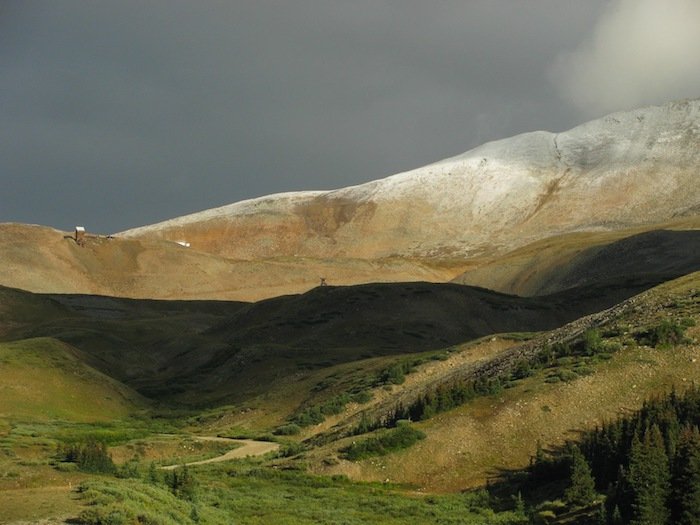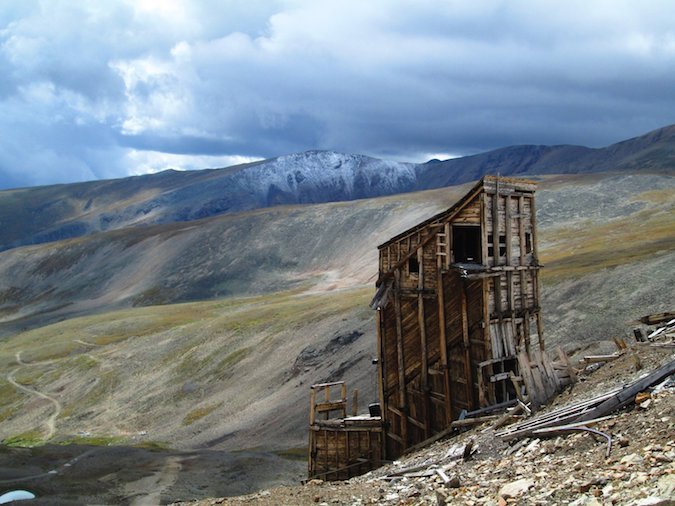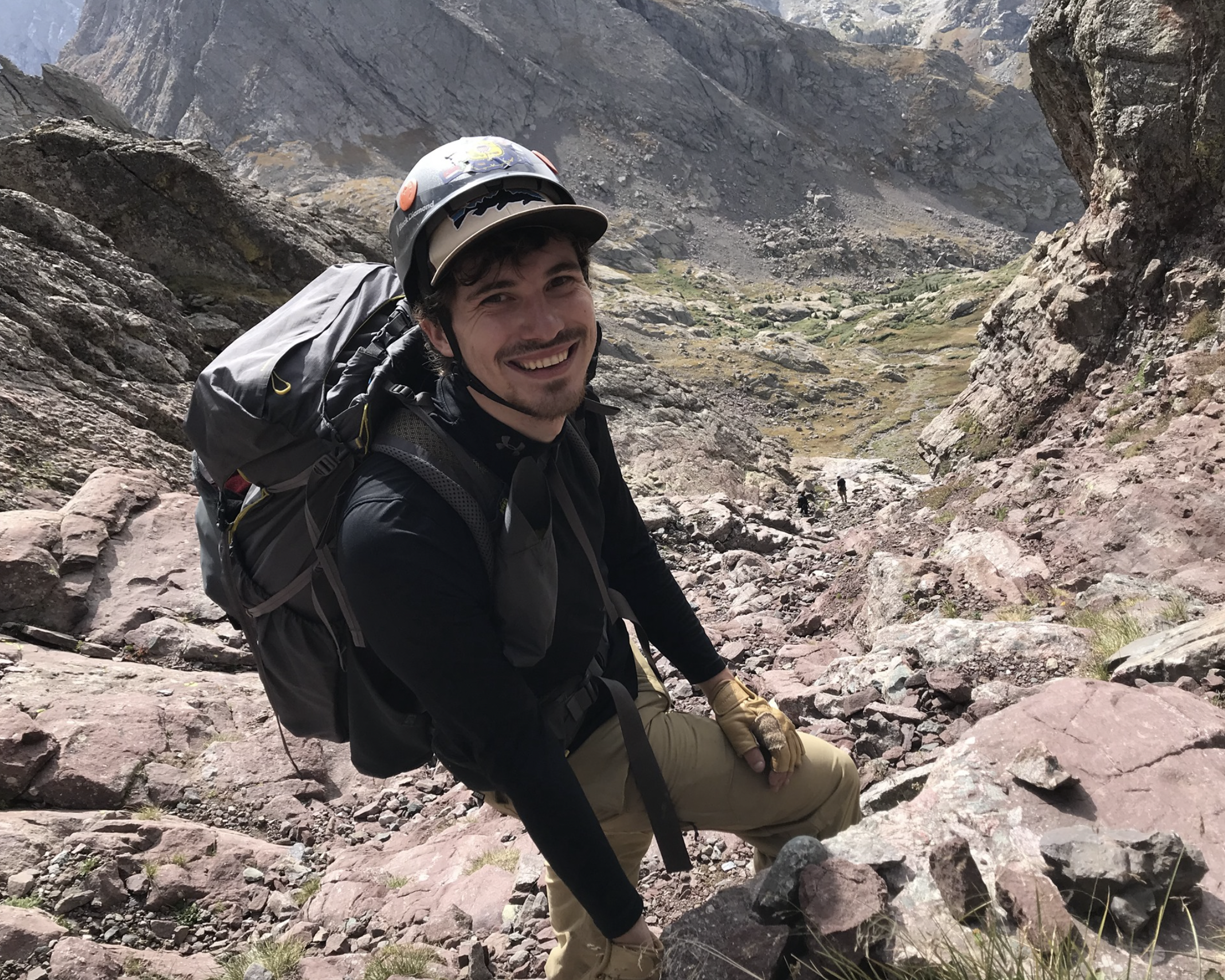Taken from the DeCaLiBron, a Colorado link-up of four 14ers—Mt. Democrat, Mt. Cameron, Mt. Lincoln, and Mt. Bross. Lincoln and Bross are on private land. PC: Lucy Hooper
by Alex Derr
Climbing, bouldering, and mountaineering are inherently risky activities—we all know that. Loose rocks, extreme weather, and freak accidents are just a few of the threats we face when we head to the mountains. For many, that sense of uncertainty and adventure is part of what makes it so special. Risk is the price we pay to practice our passion. However, while climbers often discuss aspects of personal risk, including how to identify risk, manage, and mitigate it, we rarely discuss the flip side of the coin: personal liability. Every now and then, debates break out into the open over who is ultimately responsible for ensuring climber safety. Is it climbers themselves, the broader climbing community, or the managers and owners of the land they climb on?
Personal liability pertains to the ethical and legal obligations someone may have in the event of injury, damage, or loss while engaged in recreational activities such as climbing. If an individual is deemed liable for your injury, you have the legal right to sue for damages. This serves not only as a method for financial recovery but also as a deterrent against future negligence to ensure the safety of others. To fully understand this complex issue, it's helpful to envision liability and risk as two ends of a continuum related to recreational responsibility.
On one end, you have individuals who fully accept personal risk. These people assume complete responsibility for their own safety, attributing any accidents to either their own actions or natural phenomena. On the other end are those who believe that the onus of their safety largely falls on others. According to this perspective, climbers are entitled to be warned of, or protected from, any potential hazards while engaged in climbing activities. In cases where that isn’t possible, trails or crags should be closed if that is what is required to keep the public safe.
In reality, most climbers fall somewhere in the middle, leaning ever so slightly in the direction of personal risk. We appreciate that safety is ultimately our own responsibility, while acknowledging that in some cases, others may bear some responsibility for accidents and injuries. For example, few climbers would ever consider suing a landowner because they fell and were injured because a handhold broke or an anchor gave way. However, if a landowner purposefully damaged the anchors to try and deter climbing, most would consider them liable for injuries that result.
Mt. Sherman, one of Colorado’s 14ers that is on private land. PC: Katie Sauter
Historically, personal liability has been more than a mere theoretical issue. In the 1960s, demand for recreation access started to grow as the population boomed and hiking, camping, climbing, and skiing surged in popularity. Public lands were filling up, so climbers and other groups sought out new wild places on private land and sought permission to access them. While landowners were often sympathetic, they faced significant legal hurdles that led many to refuse. At the time, the legal system used three categories to determine what duty of care a landowner owed visitors on their land.
Trespassers (individuals without permission), had a very low duty of care. Landowners could only be sued if they intentionally harmed them. However, licensees (individuals with implicit permission) had a much higher standard, with landowners expected to warn them of dangerous conditions, mitigate hazards, and close the land if necessary to ensure safety. Lastly, invitees (individuals present as part of a commercial transaction) had the highest standard, as landowners had to proactively inspect their property to identify and remove hazards.
Depending on the specific circumstances, climbers and hikers were usually classified as either invitees or licensees, leaving landowners open to significant lawsuits if they were injured or killed due to a landowner’s perceived negligence. A series of high profile lawsuits in multiple states created a chilling effect that made it nearly impossible to gain access to private areas for recreation in most parts of the country.
AAC grant recipients climbing Crestone Needle. One trailhead to access Crestone Needle is on private land.
To address the situation, the National Conference of State Legislatures crafted a model statute in 1965 called a recreational use statute (RUS). The original draft was relatively simple: in exchange for providing free public access on their land, landowners would receive strong legal protections, leaving them liable for injuries only when they willfully or maliciously fail to warn visitors of known dangerous hazards. Within a decade, all 50 states adopted a RUS to protect landowners, promote personal responsibility, and keep access open for outdoor recreation.
While all recreational use statutes are based on the first Model Act, they have been amended and added to many times over the decades in response to lawsuits, accidents, and changes in the way we recreate and enjoy the outdoors. For example, the first statutes adopted only protected private landowners, despite the fact that public lands were also at risk of major lawsuits. In 1979, an updated model act addressed this gap, with added clarification that recreational use statutes were intended to protect owners and managers of both private and public lands. While most states have adopted this change, there are still a few outliers.
Another significant difference across recreational use statutes are their exceptions. No RUS provides a blanket liability shield. Each lists a few situations where a landowner might still be found liable, in an effort to balance public access with public safety. In all 50 states, landowners are held responsible if they intentionally inflict harm—by setting traps, for example, or deliberately tampering with safety equipment. Additionally, most states leave landowners liable for injuries if they charge an access fee or run a commercial operation on their land. Beyond those conditions, there is widespread variation from state-to-state.
For example, Ohio’s recreational use statute protects landowners in almost every circumstance; they can only be sued if they injure someone purposefully and maliciously. On the other hand, 12 states leave landowners liable for willful and wanton activities or grossly negligent actions, and more than 20 states require landowners to warn visitors of any known dangerous conditions on their land. This creates a substantial burden, especially for large land holdings where there may be hundreds of known hazards, which must all be addressed to protect them from liability. In areas where climbing is popular, this can be an even greater lift, as installing warning signs on rocky terrain is both time-consuming and expensive.
The author on Mt. Sherman, one of the CO 14ers that is on private land.
Colorado offers a case in point. A 2018 Federal Court ruling held the U.S. Air Force Academy accountable for a bicyclist's severe injuries sustained on a known hazardous trail on their property. The court ordered the Academy to pay $7.8 million in damages. Following the ruling, four major peaks were closed to the public within a two-year period: Mount Lindsey, Mount Democrat, Mount Cameron, and Mount Lincoln. Though legal experts and the Colorado Trial Lawyers Association argued that this verdict was an outlier, the decision nevertheless prompted many landowners to close their lands to avoid potential lawsuits. Some peaks have temporarily reopened, thanks to a cooperative liability waiver system, but their long-term status remains in flux as advocacy groups like the American Alpine Club push for legislative revisions.
Culebra Peak, one of Colorado’s 14ers on private land. Photo courtesy of the American Alpine Club Library
Recreational use statutes can also affect our access to public lands. Flaws in a RUS can have major impacts on access to state parks and other lands, as demonstrated by the situation in Hawaii. In 1999, dozens of people were relaxing and swimming in a pool at Sacred Falls State Park when a rockslide came down the mountain above them. When the dust settled and first responders arrived, they found eight dead and more than thirty others wounded. Within a few months, several of the victims and their families filed a lawsuit against the state, eventually winning $8 million in a settlement agreement with the Attorney General.
Unlike other states, Hawaii’s legislature specified that public lands were not covered under the RUS, leaving them at a higher risk of liability than most state land managers. In the case of Sacred Falls, the state had installed ten different warning signs to let visitors know about the danger of falling rocks. The court found that the signs did not meet the standard of care owed to the visitors—and thus the state was liable for their injuries.
The lawsuit’s impacts were immediate and significant. In addition to Sacred Falls State Park, more than 20 different trails, parks, and wilderness areas were closed to the public. The state could no longer count on the protection of their RUS and decided the risk was too great to allow the public to access these areas. One of the biggest losses was the Mokulēʻia Wall, a 95-foot climbing crag famous for its multiple routes on the shores of Oahu.
Hawaii’s climbing community did not stand idle. After two and a half years of negotiations and discussions with the Hawaii Department of Land and Natural Resources, they formed the Hawaii Climbers Coalition and received a permit to resume climbing at Mokulēʻia, provided they handle visitor education, anchor inspection, and record-keeping to reduce the liability risks for the state. While these partnerships have been able to keep some areas open, many remain closed—and numerous attempts to address the situation through updates to the law have fizzled out due to opposition by the state’s Trial Lawyers Association.
As more people continue to embrace outdoor recreation, including climbing and mountaineering, we can expect recreational use statutes to become even more relevant. With public lands and parks filling up, and new permit and reservation systems launching each year, there has never been a greater need to work with private landowners to expand access to rural lands for outdoor adventure. There are many potential ways that states can improve these statutes, provide stronger safeguards and flexibility for landowners, and thereby incentivize access for the public.
Some states are providing landowners more flexibility to charge use or access fees. Most recreational use statutes only apply if access is granted to the public without charge. However, this leaves the landowner with no way to raise money to install warning signs, maintain trails, and clean up after visitors. It also limits their ability to purchase liability insurance or pay to run a waiver system—both of which significantly increase their protection. By allowing landowners to collect a small fee, with an annual and individual cap, states give them more ability to manage the impacts of access and provide more protection for themselves from lawsuits.
Another place where states can make changes is the issue of attractive nuisances. This doctrine applies to hazards like swimming pools, mining ruins, or farming equipment that are obviously dangerous to adults, but are attractive to children who are unable to appreciate the danger they face. Typically, landowners remain liable for injuries caused by an attractive nuisance, unless they install a fence or other barriers to keep the area inaccessible. These nuisances are common along 14er trails and backpacking routes in the western mountains, and would require major investments and installations to fence off. To address this gap, Colorado amended its RUS in 2005 to shield landowners from attractive nuisance claims that stem from abandoned mining ruins, while leaving the doctrine alone in most other situations. In most other states, this liability risk remains open.
An example of an attractive nuisance, on Mt. Sherman. This building collapsed in 2016-17. PC: Katie Sauter
Finally, many states have added specific clauses, exceptions, or amendments to address specific landowner concerns or complaints. For example, New Hampshire’s RUS includes a provision that states visitors must remain on designated trails and away from farming equipment or they are automatically classified as trespassers. This addressed concerns among farmers that people would wander and injure themselves while exploring old barns, fields, or irrigation ditches. In Rhode Island, the legislature added a clarification that municipalities were protected after a woman broke her leg walking in a city park and filed a lawsuit against its managers.
No one wants to get injured while hiking, climbing, or mountaineering. Yet we all acknowledge that outdoor recreation is inherently dangerous: especially in rugged, mountainous terrain. At the same time, we appreciate that those with the ability to warn visitors about a dangerous hazard should do so if it is within their power. Recreational use statutes represent our best attempt to balance these competing priorities: personal risk and personal liability. Only time will tell how these statutes continue to evolve as the demand for recreation increases.
In the meantime, by continuing to work with landowners rather than against them, working hard to help manage and mitigate our own risk, and listening to and helping address their concerns whenever possible, we can all help keep these amazing places open to the public for generations to come. To learn more and support the work of the American Alpine Club and their partners to adapt Colorado’s statute and protect access to the state’s 14ers, visit www.fixCRUS.org.
About the Author
The author halfway up the Red Gully on Crestone Peak in September 2020.
Alex Derr is a climber, advocate, and environmental policy expert. As secretary of the Fix CRUS Coalition, he is working with more than 40 organizations to strengthen Colorado’s recreational use statute to secure public access to all of the state’s 14ers, trails, and wild areas on private lands. He is Founder and Director of The Next Summit, a blog focused on mountain safety and Leave No Trace in the American West. He is also the Director of Marketing & Communications at Visible Network Labs, a startup that uses social network analysis to map and strengthen cross-sector partnerships. He lives in Aurora, Colorado with his partner Jake and their dog Summit.







